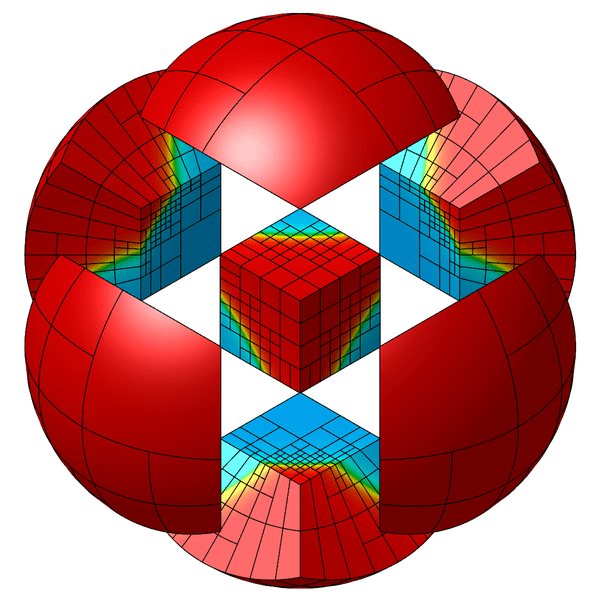- Teacher: AKELLA YESWANTH MECH_STAFF
- Teacher: K Tulasi Mech_Staff
- Teacher: Mr. N. Raghuveer MECH_STAFF
FINITE ELEMENT METHODS
|
Course Category |
Professional Core |
Course Code |
16ME7T27 |
|
Course Type |
Theory |
L-T-P-C |
4-0-0-3 |
|
Prerequisites |
Strength of materials, heat transfer, matrix calculations. |
Internal Assessment Semester End Examination Total Marks |
40 60 100 |
|
COURSE OBJECTIVES |
|
|
1. |
The basic principles of finite element analysis procedure. |
|
2. |
Concept of discretization and characteristics of finite elements that represent engineering structures. |
|
3. |
The analysis of trusses and beams. |
|
4. |
Analysis of 2-D problems. |
|
5. |
The use of higher order elements for 1-D and 2-D problems. |
|
6. |
To solve heat transfer and other field problems using FEM and FE procedure for dynamic analysis of structures. |
|
COURSE OUTCOMES |
||
|
Upon successful completion of the course, the student will be able to: |
BLOOMS TAXONOMY LEVEL |
|
|
CO1 |
Demonstrate the variational methods and weighted residual methods for solution to engineering problems. |
Analyzing |
|
CO2 |
Explain the various steps in the procedure for FEM. |
Understanding |
|
CO3 |
Solve the one-dimensional problems like trusses and beams by FEM |
Analyzing |
|
CO4 |
Solve the 2-D problems using CST and axi-symmetric elements. |
Analyzing |
|
CO5 |
Solve the 1-D and 2-D using higher order elements. |
Analyzing |
|
CO6 |
Solve the heat transfer, torsional and free vibration problems |
Analyzing |
|
Contribution of Course Outcomes towards achievement of Program |
|||||||||||||||
|
Outcomes (1 – Low, 2 - Medium, 3 – High) |
|||||||||||||||
|
|
PO1 |
PO2 |
PO3 |
PO4 |
PO5 |
PO6 |
PO7 |
PO8 |
PO9 |
PO10 |
PO11 |
PO12 |
PSO1 |
PSO2 |
|
|
CO1 |
3 |
3 |
3 |
3 |
3 |
- |
- |
- |
2 |
- |
- |
2 |
3 |
3 |
|
|
CO2 |
3 |
3 |
3 |
3 |
3 |
- |
- |
- |
2 |
- |
- |
2 |
3 |
3 |
|
|
CO3 |
3 |
3 |
3 |
3 |
3 |
- |
- |
- |
2 |
- |
2 |
- |
3 |
3 |
|
|
CO4 |
3 |
3 |
3 |
3 |
3 |
- |
- |
- |
2 |
- |
2 |
2 |
3 |
- |
|
|
CO5 |
3 |
3 |
3 |
3 |
3 |
- |
- |
- |
2 |
- |
2 |
2 |
3 |
3 |
|
|
CO6 |
3 |
3 |
3 |
3 |
3 |
- |
- |
- |
2 |
- |
2 |
2 |
3 |
3 |
|
|
COURSE CONTENT |
|
|
UNIT I |
Introduction to finite element method, stress and equilibrium, strain – displacement relations, stress – strain relations, plane stress and plane strain conditions, variational and weighted residual methods, concept of potential energy, one dimensional problems. |
|
UNIT II |
Discretization of domain, element shapes, discretization procedures, assembly of stiffness matrix, band width, node numbering, mesh generation, interpolation functions, local and global coordinates, convergence requirements, treatment of boundary conditions. |
|
UNIT III |
Analysis of Trusses: Finite element modeling, coordinates and shape functions, assembly of global stiffness matrix and load vector, finite element equations, treatment of boundary conditions, stress, strain and support reaction calculations. Analysis of Beams: Element stiffness matrix for Hermite beam element, derivation of load vector for concentrated and UDL, simple problems on beams. |
|
UNIT IV |
Finite element modeling of two-dimensional stress analysis with constant strain triangles and treatment of boundary conditions, formulation of axisymmetric problems. |
|
UNIT V |
Higher order and isoparametric elements: One dimensional quadratic and cubic elements in natural coordinates, two dimensional four noded isoparametric elements and numerical integration. |
|
UNIT VI |
Steady state heat transfer analysis: one dimensional analysis of a fin and two-dimensional analysis of thin plate, analysis of a uniform shaft subjected to torsion. Dynamic Analysis: Formulation of finite element model, element consistent and lumped mass matrices, evaluation of eigen values and eigen vectors, free vibration analysis. |
|
TEXT BOOKS |
|
|
1. |
Introduction to Finite Elements in Engineering / Chandraputla, Ashok and Belegundu / Prentice – Hall. |
|
2. |
The Finite Element Methods in Engineering / SS Rao / Pergamon. |
|
REFERENCE BOOKS |
|
|
1. |
Finite Element Method with applications in Engineering / YM Desai, Eldho & Shah /Pearson publishers. |
|
2. |
An introduction to Finite Element Method / JN Reddy / McGrawHill. |
|
3. |
The Finite Element Method for Engineers – Kenneth H. Huebner, Donald L. Dewhirst, Douglas E. Smith and Ted G. Byrom / John Wiley & sons (ASIA) Pte Ltd. |
|
4. |
Finite Element Analysis: Theory and Application with Ansys, Saeed Moaveniu, Pearson Education. |
|
WEB REFERENCES |
|
|
1. |
http://web.mit.edu/kjb/www/Books/FEP_2nd_Edition_4th_Printing.pdf |
|
2. |
|
|
3. |
http://home.iitk.ac.in/~sbasu/me623_2006/fem_notes_me623.pdf |
|
4. |
http://mech.iust.ac.ir/files/mech/madoliat_bcc09/pdf/yijun_liu___nummeth_20040121_fem.pdf |
|
5. |
http://nptel.iitm.ac.in/video.php?courseId=1012 |
|
6. |
http://www.finite-element-method.info/ |

- Teacher: Mr D.J.Johnson MECH_STAFF
- Teacher: Mr. S. Srikanth MECH_STAFF
- Teacher: Mr. M. Rambabu MECH_STAFF
- Teacher: Mrs. K. Aravinda MECH_STAFF
- Teacher: MRS. P.GAYATHRI MECH_STAFF
- Teacher: Mr. P. Ramprasad MECH_STAFF
- Teacher: S Hemani MECH_staff
